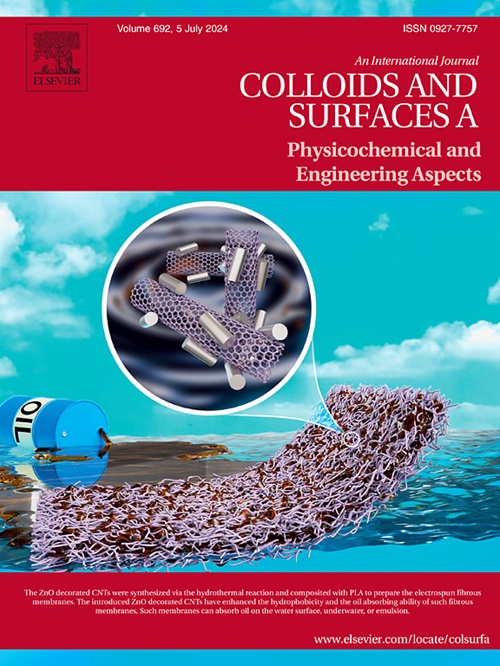Dual-functional antireflection and antimicrobial PA/Cu2+/PDA silica coating via interface charge assembly
IF 4.9
2区 化学
Q2 CHEMISTRY, PHYSICAL
Colloids and Surfaces A: Physicochemical and Engineering Aspects
Pub Date : 2025-04-29
DOI:10.1016/j.colsurfa.2025.137077
引用次数: 0
Abstract
SiO2 antireflection coating holds great promise in the optimization of optical lenses. However, their inherent hydrophilic and porous properties cause their surface to be susceptible to contamination by microorganisms. Herein, a SiO2 antireflection coating with an antimicrobial surface is designed and fabricated by interface assembling polydopamine (PDA), Cu2+ and phytic acid (PA) on the SiO2 coating to obtain a sustained antibacterial property. The phenolic hydroxyl group in PDA provides a large number of active sites for the chelating of Cu2+, thus endowing the coating with antibacterial properties (GSP-Cu2+). Further coordination with PA controls the release rate of Cu2+ and prolongs the service life of the antimicrobial coating (GSPP). Under the optimal conditions, the GSPP0.1 coating achieved an antibacterial efficacy exceeding 99.99 % (E. coli and S. aureus antimicrobial rate > 99.9 % at 6 h). Compared to the GSP-Cu2+ coating (0 %), the GSPP0.1 coating still maintains an antibacterial efficacy of more than 80 % against E. coli and S. aureus after 12 days’ immersion in water, while maintaining the light transmittance above 96 %. These results demonstrate a promising potential for the practical functional antireflection.
通过界面电荷组装的双功能抗反射抗菌PA/Cu2+/PDA二氧化硅涂层
二氧化硅减反射涂层在光学透镜的优化方面具有很大的前景。然而,它们固有的亲水性和多孔性使它们的表面容易受到微生物的污染。本文通过将聚多巴胺(PDA)、Cu2+和植酸(PA)在SiO2涂层上进行界面组装,设计并制备了具有抗菌表面的SiO2增透涂层,以获得持续的抗菌性能。PDA中的酚羟基为Cu2+的螯合提供了大量的活性位点,从而赋予了涂层抗菌性能(GSP-Cu2+)。与PA的进一步配合可控制Cu2+的释放速度,延长抗菌涂层(GSPP)的使用寿命。在最优条件下,GSPP0.1涂层的抗菌效果超过99.99 %(大肠杆菌和金黄色葡萄球菌的抗菌率>;99.9 % at 6 h)。与GSP-Cu2+涂层(0 %)相比,GSPP0.1涂层在水中浸泡12天后,对大肠杆菌和金黄色葡萄球菌的抗菌效果仍保持在80 %以上,同时透光率保持在96 %以上。这些结果显示了在实际功能抗反射中具有良好的潜力。
本文章由计算机程序翻译,如有差异,请以英文原文为准。
求助全文
约1分钟内获得全文
求助全文
来源期刊
CiteScore
8.70
自引率
9.60%
发文量
2421
审稿时长
56 days
期刊介绍:
Colloids and Surfaces A: Physicochemical and Engineering Aspects is an international journal devoted to the science underlying applications of colloids and interfacial phenomena.
The journal aims at publishing high quality research papers featuring new materials or new insights into the role of colloid and interface science in (for example) food, energy, minerals processing, pharmaceuticals or the environment.

 求助内容:
求助内容: 应助结果提醒方式:
应助结果提醒方式:


